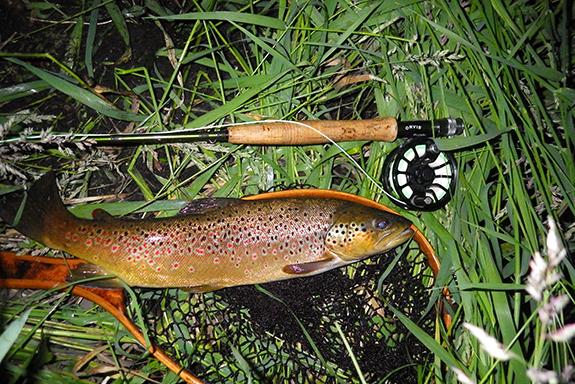Thanksgiving remem-brances of a unique year will not be forgotten. Without dwelling on the upsets and disappointments, there remains a constancy which helped those who sought to preserve. It is that the trout streams continued to flow and there in the wondrousness of what a trout stream brings forth buoyed those who partook of their benefits.
In early season, the hearty fishers waded through snowbanks casting Perigon nymphs to drift deep runs and pools where trout lay. Despite the coldness of early season some trout were game and in turn were shortly returned to their refuge. Winter stoneflies migrated over snow drifts in March searching for mates and then in fluttering flight returned to streams and hungry trout.
Spring brought forth the early caddis hatch called differently by fishers as Black Caddis or American Grannom. This hatch draws those seeking the first good chance at surface dry fly fishing since the previous fall’s late minor Blue Wing Olive hatch. The optimal time is early to mid-afternoon; however, arriving in advance at the stream is often necessary for claiming ideal locations. Careful observation disclosed trout chasing caddis emergers, as they swam up to break through the stream surface. It was later when caddis returned to the stream as vulnerable adults laying eggs that true dry fly surface fishing happened. The fly size preferred was a #18 tied in Elk Wing style modified to include an olive-yellow wrapped shank.
Camaraderie was accom-plished at rod length. No shoulder to shoulder discussions of the finer points of a trout rising or fly that wins the day. Stream side lunches were held in voiced volume exceeding the rush of winds tossing treetops about. Departing conversations in parking lots were extended in compensation for the solitary return trip home.
June, a month always anticipated for so many reasons, one being the Hexagenia mayfly hatch. Fishers from four surrounding states commonly converge on Central Wisconsin streams for this remarkable event. WDNR parking lots become filled and road crossings were clustered with numerous vehicles. Likely the numbers were higher than typical this season as many fishers traveled single to achieve the proper distancing.
Hex mayflies make night-owls of anglers since they usually take to flight and form mating swarms after 9 p.m. in a spectacular flight comprised of thousands. On warm humid nights, tens of thousands take flight in a rush of wings that wanes as mating subsides and spent adults litter the stream surface. The sound of rising trout is never so evident as now. The smaller trout make splashy shallow sounding rises, moderate to large trout feed with a gulping sound and some of the big old timer trout hide under low branches and sip the flies in a long-practiced manner.
Understanding these sounds was a principle determinant of success just as much as time taken before the hatch to define locations of snag free casting lanes. In darkness, the selection of the desired sound was made and casts were placed just a bit upstream with appropriate accuracy. It was the hard tug, the zig zag runs and a full net that was the topic of our parking lot talk. A talk that was among strangers or for those with recognizable voices it was among friends and acquaintances that punctuated the inky darkness.
Hoppers with droppers were the fly combination for July and August as grasses crowded the streams where hoppers and cricket misstepp and alight on the water. Surface strikes on flies by trout could not be a greater thrill. The hotness of these days was easily dampened by just wading in the coolness of a stream.
So it was in thankfulness for trout streams some of us have weathered this year. We traveled separately, we fished separately and at rod distance felt the comradery of previous seasons. In appreciation for what we have been Given we look forward to next season.


